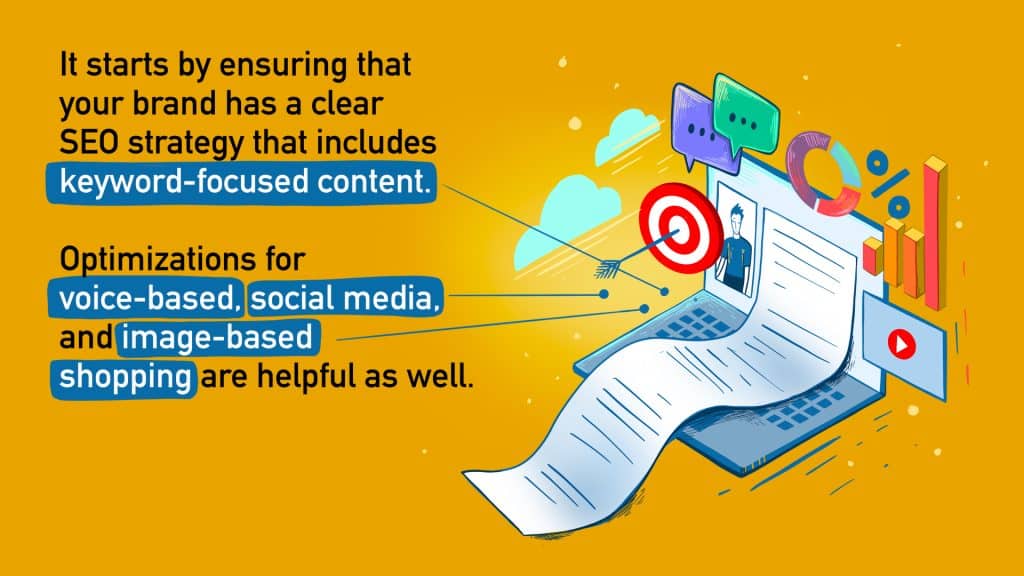
In the competitive world of omnichannel ecommerce, visibility matters. Every minor change in either your brand’s or products’ search engine results page (SERPS) position on the marketplaces where you sell and on search engines where you appear can translate to significant fluctuations in sales potential.
As such, you must be keenly aware of who is competing against your products for those coveted search-ranking positions. Luckily, there are plenty of search engine optimization (SEO) tools—both free and paid—that can give you the insights that you need into both your closest competitors and keyword leaders. From there, you can evaluate your listings and brand content to optimize your web presence and outperform your rivals.
Identify the Competition
SEO-based competitor research can be a deep rabbit hole if you’re not focused. The first step is correctly identifying the competitors costing you the most potential business. It starts by ensuring that your brand has a clear SEO strategy that includes keyword-focused content. Optimizations for voice-based, social media-based, and image-based shopping are also helpful.
Once you have the short—and long-tail keywords you identified while optimizing your content, you have what you need to hone in on your competitors who are vying for the same customers you are. These are the keywords that you need to search using a neutral web browser (one in private browsing mode, free from any algorithmic influence based on your logins or search habits) on search engines, marketplace channels, and social media.
These are also the keywords to run through SEO tools, such as those featured in SEO guru Neil Patel’s 25 Online Competitor Analysis Tools. When you start accumulating results from these investigative searches, two types are particularly worthwhile to target:
Nearest Neighbors
These competitors rank 1-3 positions above and below you for your brand and product keywords. They represent the greatest potential rivals to overtake and those most poised to surpass you.
Keyword Leaders
Top performers for a particular keyword get the lion’s share of the clicks and attention. This is why search engines and marketplaces offer the opportunity for sponsored results in these key positions. In opposition research, however, you are typically only focused on organic results—keyword competitors whose SERPS success is solely based on SEO algorithmic performance.
That said, it is worth noting if the same sellers regularly dominate the sponsored results for particular keywords. This is typically a tell-tale sign that the investment is paying off for them. Once you have a handful of these types of competitors for a particular keyword, it’s time to dig in.

Use SEO Research to Unearth Your Competitors’ Strategies
If you’re not careful, competitor research can drain your time and focus. You need to have clear objectives and know what data you are looking for. Ultimately, you want intel that is relevant to your brand and provides actionable insights that can help you improve the visibility of your products.
Some of the best areas to start with include:
Traffic Sources
One of the most important questions you must answer is where your competitors’ customers come from. This is a question that has many parts:
- What are the demographics they are attracting?
- How are their customers finding their products?
- What links, search engines, platforms, and social media channels are responsible for funneling traffic to their brands and products?
SEO tools to track these answers can help you stay current on potential sources for boosting customer engagement and sales conversions.
Alternate Keywords
One of the most tried-and-true SEO strategies for competitor research is identifying and poaching your competitors’ top-performing keywords. If certain words and phrases routinely bring customers to your competitors’ listings, you must ensure they are incorporated into your listing titles, product descriptions, social media posts, and website copy when appropriate.
Content Tone
Tone is more of an abstract notion than keywords, but the nuance and style with which your competitors use language can tell you a lot about both their audience and brand priorities. While it is normal and acceptable to steal high-performing keywords from your rivals, you should not try to reproduce tone wholesale.
Rather, the tone used by other brands can illuminate untapped, hidden, or secondary audiences for your brand and products. This information can help you explore new sales channels and give your marketing team ideas for new strategies.
Content Substance
Pay attention to what your competition uses their valuable web space, description characters, and social media accounts for. In particular, take notice of the images, videos, branding, and layouts of their highest-traffic content. Something beyond keywords is attracting visitors and views – you need to know what it is.
Multichannel Reach
Pay attention to where your competitors are listing their products and where they stand in the SERPs across the channels where they sell. Channels where they rank highly may indicate less competition for your keyword and/or larger potentially interested audiences. Likewise, channels where they are underperforming may signify either a lack of attention and/or a lack of viability.
Apply What You Learn to Your Omnichannel Ecommerce Brand
Research is only as good as what you do with it. To remain competitive in ecommerce, your forward-facing content must be constantly evolving. As you uncover new viable keywords, audiences, marketplaces, and marketing strategies worth pursuing, be sure that you are putting the best of them into action for yourself.
Research also needs to be a continuous commitment rather than a one-and-done proposition. Keeping tabs on your rivals is the only way to stay on top of upward and downward trends that may predict the viability of particular strategies. Just as you should track the effectiveness of changes you make based on your opposition research, you should also monitor the trends that led you to make those changes in the first place.
This will help you determine where to redouble your efforts and which leads aren’t worth pursuing. Whatever modifications you decide to implement, Descartes Sellercloud’s catalog management features streamline the process by allowing you to make changes once and have them pushed out live across your entire omnichannel presence.
Taking things a step further, Descartes Sellercloud’s shadow products feature allows users to create alternate listings for A/B testing purposes or varied marketing targets. Shadow SKUs can be created to pull despite the fact that shadow SKUs referring to the same parent SKU can be set to pull from singular inventory stockpiles without disrupting your supply chain, warehousing, or fulfillment workflows.
For more information, contact us directly for a free demo and see for yourself how Descartes Sellercloud gives you the omnichannel tools and support needed to outperform competitors in omnichannel visibility and logistical and fulfillment efficiency.




